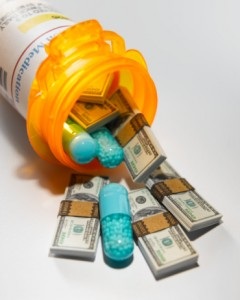
Almost always, one drug can have multiple names. This becomes confusing when it comes time to select over-the-counter medications. For example, the very well known drug Tylenol, can also be known as acetominophen and/or non-aspirin pain reliever. So...
What's the Difference?
When a drug is first marketed, it is given a brand name by the company that produced it. During the time that the patent for the drug is effective, no other companies are allowed to make that drug. However, once the patent time is up (usually around 20 years), other companies are allowed to make similar versions of the drug. These become the generic drugs.
Generic drugs contain the same active ingredient(s) as the original and are required to have the same level of safety and efficacy by the FDA. In essence, they are the same drug as the original. Generic drugs have different inactive ingredients as the original drug because they cannot be 100% identical. This explains why brand name drugs and their generic drug counterparts often do not look the same. Another important difference is that generic drugs are always cheaper than the brand name drug, so choosing the generic version of the drug will save you a lot of money.
In writing, the names of brand name drugs are written with the first letter capitalized. Ex: Tylenol, while the names of generic drugs are written in all lowercase. Ex: acetominophen. (However, this may not be the case on drug bottles or boxes).
How To Find the Generic Drug of a Brand Name Dug
If you're at the store, look for the brand name drug you need and find the active ingredient on the back of the box. The generic drugs for the brand name drug are always placed next to the brand name drug and they are always cheaper. Check the active ingredient(s) of the nearby drugs. If the active ingredient(s) are the same, you've found the generic drug. If you're at home, you can always search online for the different generic drugs by typing in "generic drug for [insert brand name drug]".
For more information, visit the FDA's website.
What's the Difference?
When a drug is first marketed, it is given a brand name by the company that produced it. During the time that the patent for the drug is effective, no other companies are allowed to make that drug. However, once the patent time is up (usually around 20 years), other companies are allowed to make similar versions of the drug. These become the generic drugs.
Generic drugs contain the same active ingredient(s) as the original and are required to have the same level of safety and efficacy by the FDA. In essence, they are the same drug as the original. Generic drugs have different inactive ingredients as the original drug because they cannot be 100% identical. This explains why brand name drugs and their generic drug counterparts often do not look the same. Another important difference is that generic drugs are always cheaper than the brand name drug, so choosing the generic version of the drug will save you a lot of money.
In writing, the names of brand name drugs are written with the first letter capitalized. Ex: Tylenol, while the names of generic drugs are written in all lowercase. Ex: acetominophen. (However, this may not be the case on drug bottles or boxes).
How To Find the Generic Drug of a Brand Name Dug
If you're at the store, look for the brand name drug you need and find the active ingredient on the back of the box. The generic drugs for the brand name drug are always placed next to the brand name drug and they are always cheaper. Check the active ingredient(s) of the nearby drugs. If the active ingredient(s) are the same, you've found the generic drug. If you're at home, you can always search online for the different generic drugs by typing in "generic drug for [insert brand name drug]".
For more information, visit the FDA's website.




